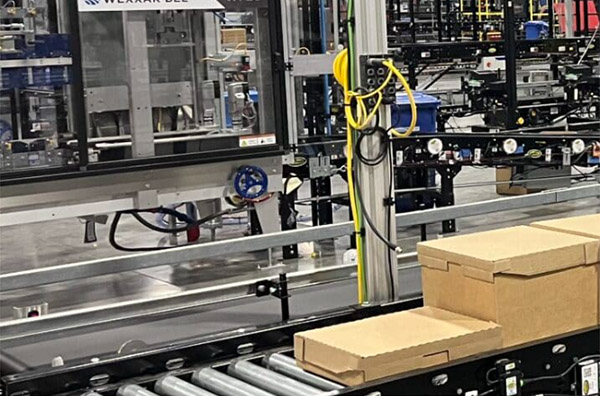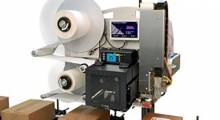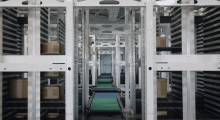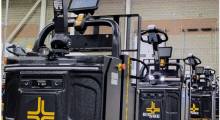While many warehouse operators are aware of the challenges posed by labor shortages and shifting demand, they may not know how automation can help them in the “last 100 feet,” according to enVista LLC. SLAM line automation is one approach to addressing this challenge, it said.
Founded in 2002, enVista builds physical and digital systems to help optimize supply chains, serving manufacturers, distributors, third-party logistics providers (3PLs), and omnichannel retailers. The company, which has offices in Carmel, Ind., and Chicago, also provides consulting and managed services.
At ProMat 2023, enVista executives explained their roadmap for helping customers integrate robotics.
Last month, MHI accepted the company into its SLAM Industry Group. (In this case, SLAM refers to “scan, label, apply, and manifest,” not simultaneous localization and mapping.) “The last 100 feet of the warehouse are critical for efficient operations, high throughput, and customer satisfaction,” stated enVista.
Robotics 24/7 recently spoke with Dennis Andre, director of enVista, and Tom Stretar, vice president of technology at enVista, about SLAM line automation.
Getting started with SLAM line automation
How would you define SLAM line automation?

Andre: In optimizing that last 100 feet of warehouse space, we get a package, dimension it and weigh it, and data goes back to the manifest. That way, companies are shipping to the actual weights.
[Our system] includes capturing data, printing the label, and verifying the application of the label before sending it to reception or sortation.
How is that different from current processes?
Andre: The most archaic way, typically seen at smaller operations, involves cart picking and bringing cartons over to a workstation. There, an operator takes each carton, puts it on a scale, and consults a master list of carton types and prepopulated dimensions.
The worker then manually applies labels, following restrictions based on where each vendor wants that label placed.
Stretar: We've worked with a sporting goods retailer that has done a lot of automation on the picking side, and it's starting to do it on the outbound side. The company sent cartons to picking stations and then another station to add fill and a manual tape line.
SLAM line automation allows us to optimize that work, pre-manifest, and it can do QA [quality assurance] checks automatically.
Dealing with variability
Does SLAM line automation need to be configured differently than other robotics or automation?
Andre: Dimensioning is a big part of the process, versus just estimating the weight. SLAM can capture box changes that were not previously captured, and we've seen big savings on the shipping side and with chargebacks.

Stretar: The WMS [warehouse management system] and manifest try to pick the box size, but vendors often change dimensions. With SLAM line automation, you can flexibly build a box around the goods.
Is this like the variability or customization challenge in other areas of robotic picking?
Andre: It's not like manufacturing, with consistent products, but where goods are picked to order and there is variable labeling.
Some companies have standards that they dictate or have to conform to. For example, some end clients require both top and side labels, so we have to be able to print multiple labels.
How long does it take for a warehouse or distribution center to get to that level of flexibility?
Andre: A lot is set in the design piece. Once you get the system set, you can design it to change by job, but it's mostly “set and forget.”
As for productivity improvements, we've seen a return on investment [ROI] in less than a year from manual to SLAM.
Stretar: Applying a UPS-type label to a box can take three to four seconds for a human, plus positioning time, void fill, packing slips, etc. We can increase throughput from a half-day to a two- to three-hour window turnaround.
Between our automation team and the industrial automation team, we can tell exactly how long an item takes from Process A to Process B. SLAM line automation eliminates some of that motion.
Warehouses are already really good with AGVs and goods-to-person systems, so they just need standardized SLAM line implementations from racking for that last 100 feet.
AI and human oversight
The component technologies aren't new—why is SLAM line automation getting attention now?
Andre: With e-commerce, there are more packages, more variation, and more strain. Companies have focused on robotics upstream, but now there's a logjam.
Stretar: It typically takes hundreds of workers in e-commerce facilities to get an object out the door. Packing stations can become a bottleneck.
There has been a lot of attention around AI lately, but what is the role of human workers going foward?
Stretar: We want to eliminate some of the highly manual processes to improve SLAs [service-level agreements] for the outbound side and to minimize returns.
With reverse logistics and repackaging as challenges, brands want to minimize returns. Automation becomes part of the decision-making process—“Can I ship this product?” “Is there an available carton?”—versus moving goods physically through the building.
How much human oversight is necessary in SLAM line automation?
Stretar: It's like the “Amazon effect”—SLA expectations for fulfillment are down from two days to hours, depending on micro-fulfillment centers and distribution networks. We want to take away as much manual intervention as we can, but there will always be some level of human support.
The differentiation between “Can a robot make that decision?” and manual operation is real. I'll be speaking with [enVista] Senior Director Cal Petty at the Parcel Forum in September about the merger of automation and labor.
Where would you like to see improvement?
Andre: SLAM line automation is a blend of robotics and human labor. Several companies are trying to robotically palletize mixed cases. Once we get past that hurdle, we can automate the end of that last 100 feet.
About the Author
Follow Robotics 24/7 on Linkedin
Article topics
Email Sign Up
















